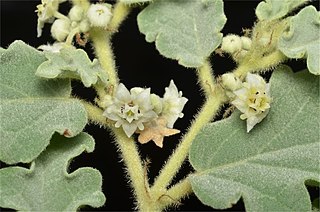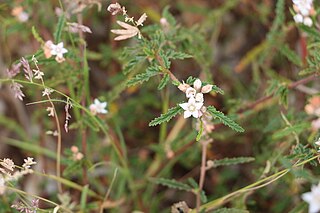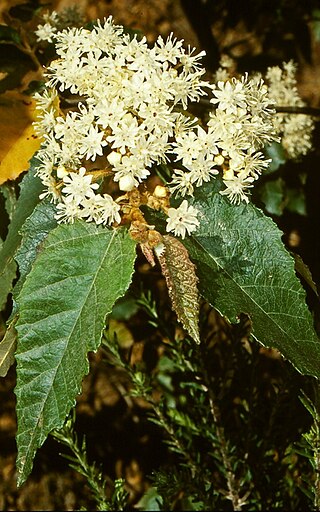
Androcalva fraseri, commonly known as blackfellow's hemp or brush kurrajong, is a species of flowering plant in the family Malvaceae and is endemic to eastern Australia. It is a small tree or shrub that forms suckers and has egg-shaped or lance-shaped leaves with serrated edges, and clusters of 13 to 21 white flowers.

Guichenotia ledifolia is a species of flowering plant in the family Malvaceae and is endemic to the southwest of Western Australia. It is a densely-branched shrub with densely hairy new growth, hairy, linear to oblong leaves and pink to mauve flowers arranged in groups of three to ten.

Quoya cuneata is a flowering plant in the mint family Lamiaceae and is endemic to the south-west of Western Australia. It is a spreading shrub with its branches and leaves covered with a layer of woolly, pale white or brownish hairs. The flowers are blue at first but become white with purple spots inside the petal tube.

Commersonia hermanniifolia, commonly known as wrinkled kerrawang, is a species of flowering plant in the family Malvaceae and is endemic to New South Wales. It is a prostrate or trailing shrub with oblong to lance-shaped leaves that are paler on the lower surface, and flowers with five white sepals fading to pink and five pinkish petals.
Commersonia grandiflora is a species of flowering plant in the family Malvaceae and is endemic to the south of Western Australia. It is an erect, open shrub with hairy, egg-shaped to elliptic leaves, and white or cream-coloured flowers.

Commersonia magniflora is a species of flowering plant in the family Malvaceae and endemic to Australia. It is an erect shrub with wrinkled, narrowly oblong to elliptic or egg-shaped leaves, and deep pink flowers.
Commersonia rotundifolia, commonly known as round-leaved rulingia, is a species of flowering plant in the family Malvaceae and endemic to the south-west of Western Australia. It is an upright, openly-branched shrub with elliptic to round leaves with wavy edges, and white flowers in clusters of 3 to 10.
Androcalva argentea is a species of flowering plant in the family Malvaceae and is endemic to Queensland. It is a tall shrub that forms suckers from rhizomes and has silvery branchlets and leaves, the leaves egg-shaped with wavy edges and serrated, and dense clusters of 10 to 30 white to cream-coloured flowers.
Androcalva beeronensis is a species of flowering plant in the family Malvaceae and is endemic to Queensland. It is a shrub that forms suckers from rhizomes and has branchlets and leaves covered with soft, golden hairs, the leaves egg-shaped to lance-shaped with toothed edges, and clusters of 9 to 24 cream-coloured to white flowers.

Androcalva crispa, commonly known as crisped leaf commersonia, is a species of flowering plant in the family Malvaceae and is endemic to the south-west of Western Australia. It is a prostrate shrub that forms suckers from rhizomes and has densely new growth, clusters of lobed, egg-shaped or oblong leaves with wavy, serrated edges, and groups of white and pinkish-purple flowers.
Androcalva inglewoodensis is a species of flowering plant in the family Malvaceae and is endemic to south-eastern Queensland. It is a spreading, prostrate shrub that has hairy young branchlets, egg-shaped to elliptic leaves with irregularly serrated edges, and small groups of white to cream-coloured flowers.

Androcalva johnsonii is a species of flowering plant in the family Malvaceae and is endemic to central Queensland. It is a low, spreading shrub that has hairy young branches, narrowly egg-shaped or oblong leaves with rounded teeth, and small groups of white to pale pink flowers.

Androcalva leichhardtii is a species of flowering plant in the family Malvaceae and is endemic to central Queensland. It is a small shrub with hairy new growth, wrinkled, egg-shaped to lance-shaped leaves with irregular serrations on the edges, and small groups of yellow flowers.

Androcalva melanopetala is a species of flowering plant in the family Malvaceae and is endemic to southern inland Western Australia. It is a sometimes prostrate shrub that has densely hairy new growth, egg-shaped to elliptic leaves with rounded teeth on the edges, and clusters of white or cream-coloured and pink to red flowers.

Androcalva multiloba is a species of flowering plant in the family Malvaceae and is endemic to the Eyre Peninsula of South Australia. It is a dwarf shrub with densely hairy, irregularly serrated, egg-shaped leaves, and up to 5 white and red flowers arranged opposite leaf axils or on the ends of branches.

Androcalva pedleyi is a species of flowering plant in the family Malvaceae and is endemic to south-eastern Queensland. It is low, spreading or prostrate shrub that forms suckers and has softly-hairy new growth, linear to lance-shaped leaves with lobes on the edges, and groups of 7 to 10 white, later pink flowers.
Androcalva perkinsiana, commonly known as headland commersonia, is a species of flowering plant in the family Malvaceae and is endemic to a restricted part of central eastern Queensland. It is a small, erect shrub with hairy young branchlets, oblong or lance-shaped leaves with 5 to 11 pairs of small serrations on the edges, and groups of 3 to 4 pale purple flowers.
Androcalva reticulata is a species of flowering plant in the family Malvaceae and is endemic to north-eastern Queensland. It is a low shrub that forms suckers, its new growth covered with star-shaped hairs, and has egg-shaped leaves with irregular teeth on the edges, and groups of two to six red flowers.

Androcalva rossii, commonly known as native hemp, is a species of flowering plant in the family Malvaceae and is endemic to south-eastern Australia. It is spindly shrub or small tree that forms suckers, its branchlets covered with star-shaped hairs, and has egg-shaped leaves with irregular teeth on the edges, and groups of 18 to 60 white or cream-coloured flowers.
Androcalva stowardii is a species of flowering plant in the family Malvaceae and is endemic to inland parts of the south-west of Western Australia. It is a prostrate to low-lying shrub with elliptic to egg-shaped leaves, the edges smoothly serrated, and clusters of three to nine or more white to cream-coloured flowers.













